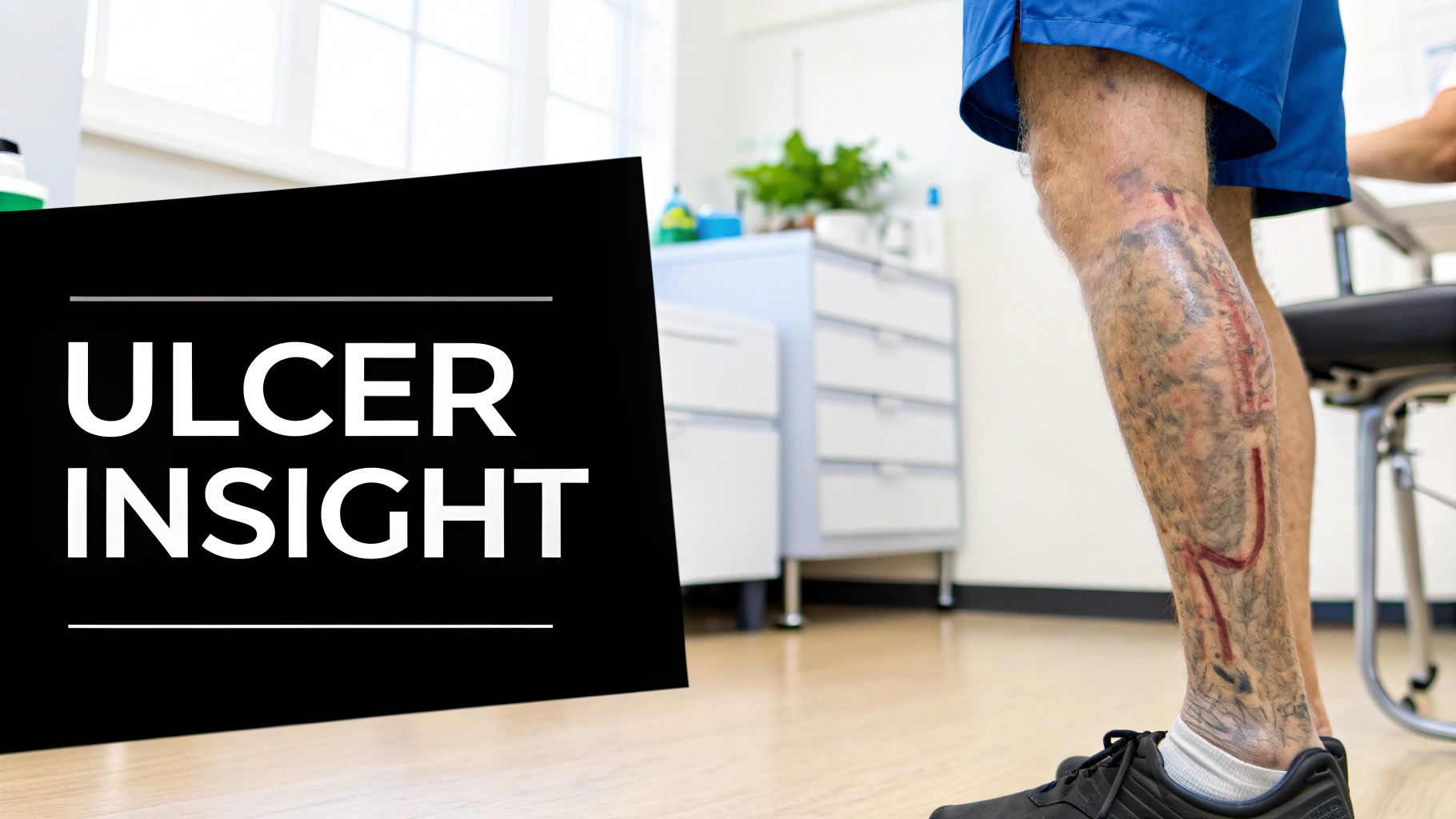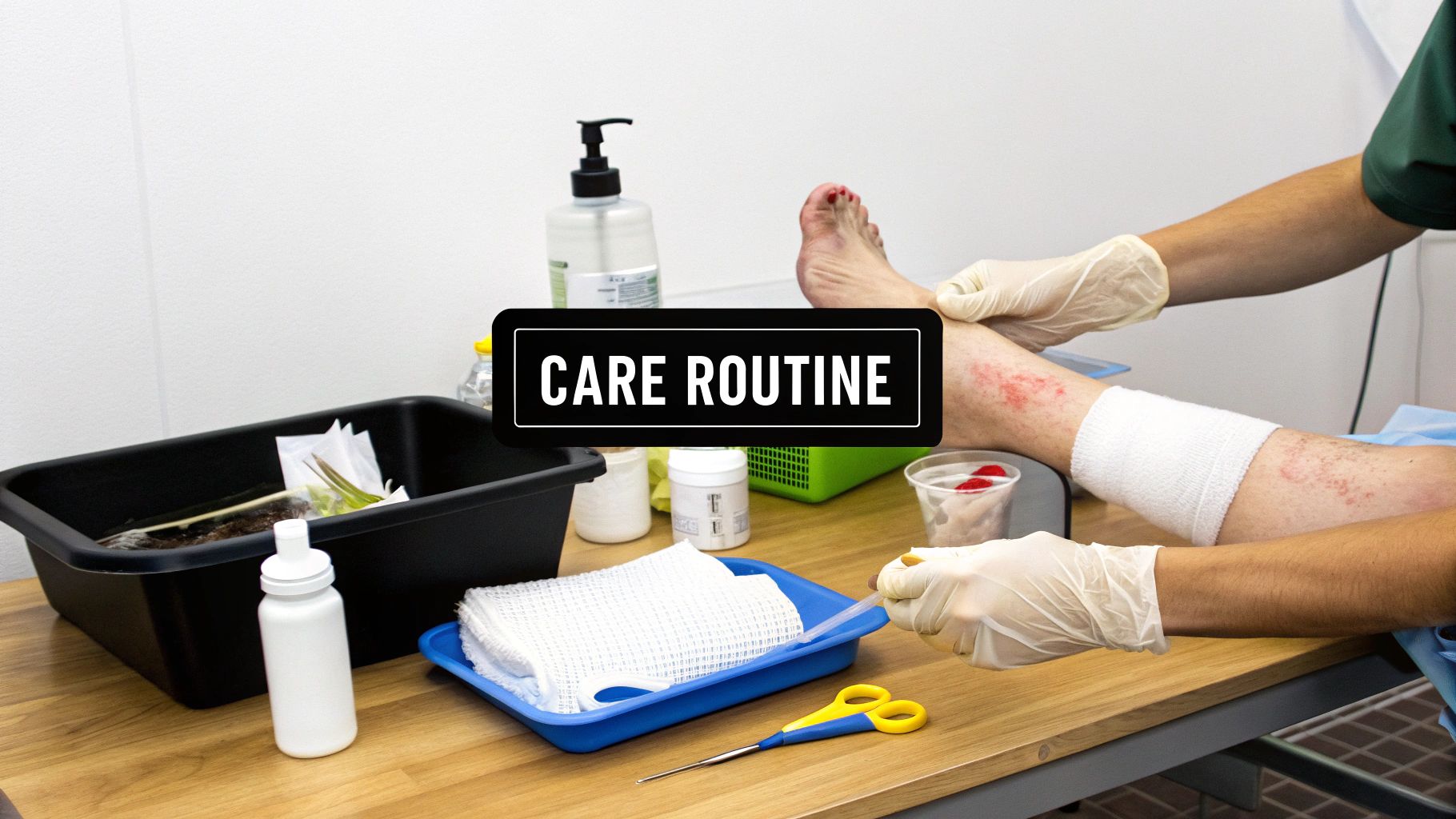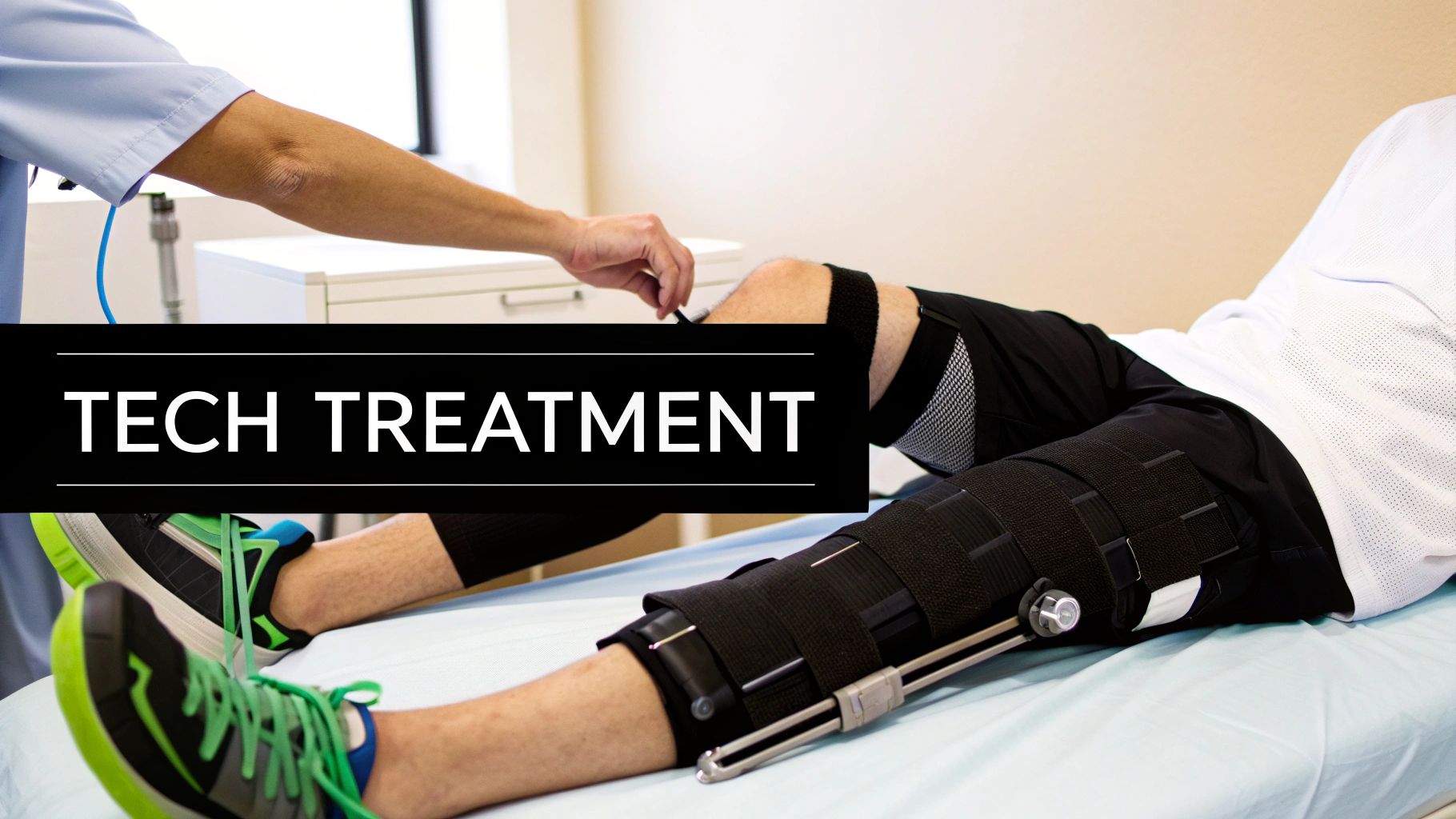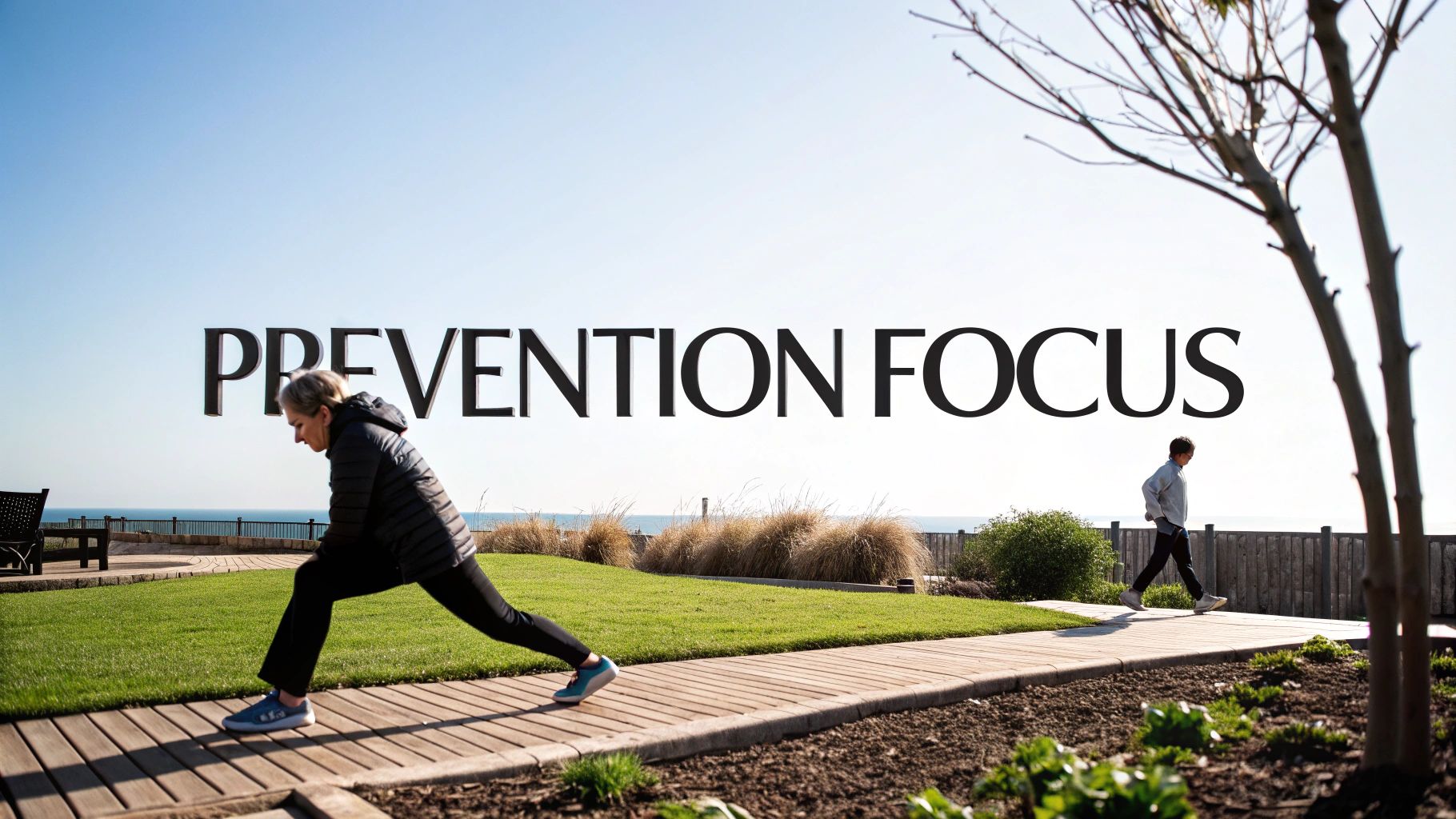Understanding Venous Leg Ulcers: Beyond the Surface

Venous leg ulcers are more than just a skin problem. They represent a complex interaction between poor circulation and compromised tissue health. This intricate process starts in the veins of our legs, which are responsible for carrying blood back to the heart. When these veins don't work correctly, a chain reaction occurs, ultimately leading to a venous leg ulcer.
The Pathophysiology of Venous Leg Ulcers
Think of the circulatory system like a network of rivers with dams and locks controlling the flow. In healthy veins, valves act like these dams, stopping blood from flowing backward. However, in chronic venous insufficiency (CVI), these valves become damaged.
This damage causes pressure to build up, similar to water accumulating behind a failing dam. This pressure, called venous hypertension, forces fluid and blood cells to leak into the surrounding tissue. This leakage triggers inflammation, the body's natural response to injury.
While inflammation is meant to heal, in this situation, it worsens tissue damage. The persistent high pressure also harms the delicate capillaries, the tiny blood vessels that deliver oxygen and nutrients. Like a drought-stricken land, the skin and underlying tissues become starved, eventually breaking down to form an ulcer.
This is why treating venous leg ulcers requires more than just addressing the wound itself. It requires managing the underlying circulatory problems.
Risk Factors and Prevalence
Several factors contribute to venous leg ulcers. Prior deep vein thrombosis (DVT) can damage venous valves, increasing the risk of CVI and ulcers. Obesity also plays a significant role by putting extra strain on the venous system. Genetic predispositions can also increase susceptibility.
The prevalence of venous leg ulcers (VLUs) is a global health concern. VLUs affect about 1% of the population aged 18–64 worldwide. This number is even higher in developed countries, impacting healthcare systems due to lengthy healing times and high recurrence rates. Learn more about the prevalence of venous leg ulcers here. Planning for long-term care is important when managing VLUs. Understanding the cost of long term care can be helpful.
The Importance of Early Intervention
Because venous leg ulcers are a complex result of underlying venous issues, early and comprehensive treatment is critical. This approach not only promotes faster healing but also helps prevent complications and reduces the chance of recurrence. The next section will discuss the cornerstone of venous leg ulcer treatment: compression therapy.
Compression Therapy: The Non-Negotiable Foundation

Compression therapy is the cornerstone of venous leg ulcer treatment. It's not just a beneficial addition, but a fundamental requirement for effective healing. This therapy works by counteracting the hemodynamic forces that contribute to ulcer formation. Think of it as reinforcing a weakened dam, preventing further leakage and allowing the surrounding area to recover.
How Compression Promotes Healing
Graduated compression, with the highest pressure at the ankle gradually decreasing up the leg, is essential. This pressure gradient encourages blood flow back to the heart, reducing venous hypertension. This minimizes fluid leakage into the tissues and improves oxygen delivery to the wound.
The improved circulation from compression helps clear waste products and inflammatory mediators. This creates a better environment for healing. Compression also supports weakened tissues, reducing edema and promoting new tissue growth.
Choosing the Right Compression System
Several compression options exist, each with its own pros and cons. Let's explore a few:
-
Multi-layer bandaging systems: These offer customizable compression levels and can adapt to changes in leg size. They are especially useful for ulcers with significant exudate or irregular shapes.
-
Adaptive wraps: These provide adjustable compression and are easier for some patients to self-apply.
-
Compression stockings: While offering consistent pressure, these may not be suitable for all leg shapes or ulcer locations.
The best compression system depends on the individual patient's needs and the ulcer's characteristics. Factors like wound size, location, exudate level, and patient mobility all play a role.
To help visualize the different options, the table below provides a comparison of various compression therapy methods:
Compression Therapy Options for Venous Leg Ulcers: A comparison of different compression therapy methods, their pressure ranges, indications, and key considerations.
| Compression Type | Pressure Range | Best For | Application Frequency | Key Benefits | Limitations |
|---|---|---|---|---|---|
| Multi-Layer Bandaging | 20-60 mmHg | Irregular shaped ulcers, high exudate | Varies, typically every 1-7 days | Customizable pressure, accommodates swelling changes | Can be bulky, requires skilled application |
| Short-Stretch Bandages | High resting pressure, low working pressure | Venous ulcers with edema | Daily or every other day | Effective edema control | May be uncomfortable for some patients, can restrict mobility |
| Long-Stretch Bandages | Low resting pressure, high working pressure | Not recommended for venous ulcers | N/A | N/A | Can impede venous return if applied incorrectly |
| Compression Stockings | 15-50 mmHg | Mild to moderate venous insufficiency, prevention | Daily | Convenient, easy to apply | May not be suitable for all leg shapes or severe ulcers |
| Adaptive Wraps | Adjustable | Moderate venous insufficiency, patients with limited mobility | Daily | Easy to adjust, good patient compliance | Can be less effective for severe ulcers |
This table summarizes the key features of each compression therapy method, allowing for easier comparison and selection based on individual patient needs. Choosing the correct system is paramount for effective treatment.
Overcoming Adherence Challenges
While compression's benefits are clear, patient adherence can be difficult. Discomfort, application difficulty, and cosmetic concerns can lead to inconsistent use. Effective patient education is crucial. Explaining the physiological benefits in simple terms empowers patients. Practical demonstrations and written instructions on bandaging can also improve adherence.
The economic impact of venous leg ulcers underscores the importance of effective treatments like compression therapy. The global VLU treatment market, valued at USD 2.96 billion in 2018, is projected to reach USD 7.21 billion by 2032, with compression therapy playing a major role. Learn more about the growth of the VLU treatment market here. This highlights the need for comprehensive strategies to address this growing health concern. Beyond compression, the next section will discuss modern wound care approaches that work alongside compression to optimize healing.
Modern Wound Care Approaches That Actually Work

Effective wound care is paramount for treating venous leg ulcers. It's not just about compression therapy; it's about choosing the right dressings and techniques based on the unique characteristics of each wound and its healing stage. This includes managing excess fluid, controlling infection, and creating an environment conducive to healing.
Assessing the Wound Bed
Skilled clinicians meticulously assess the wound bed to determine the best course of action. This involves evaluating several factors: size and depth of the wound, the amount of exudate (drainage), the presence of infection, and the condition of the surrounding skin. Just as a gardener prepares the soil for planting, clinicians must create the optimal conditions for a wound to heal.
Choosing the Right Dressing
The dressing selected should address the specific needs of the wound. For heavily draining ulcers, foam dressings are highly absorbent and beneficial. Alginate dressings, derived from seaweed, also absorb fluid effectively and contribute to a moist wound environment. If infection is present, antimicrobial dressings containing silver or iodine can be used.
The healing stage also influences dressing selection. In the initial debridement stage (when the wound is cleaning itself), dressings that promote autolytic debridement are preferred. As the wound enters the granulation phase (new tissue formation), dressings that maintain moisture and protect the delicate new tissue are key. During the final epithelialization phase (skin closure), dressings that minimize disruption to the fragile new skin are essential.
To help guide dressing selection, the following table offers an overview:
To help guide dressing selection, the following table provides a general overview of appropriate dressing types based on wound characteristics and healing stage:
Wound Dressing Selection Guide for Venous Leg Ulcers
| Wound Characteristic | Recommended Dressing Type | Change Frequency | Expected Outcomes |
|---|---|---|---|
| Heavy exudate | Foam, Alginate | Daily or as needed | Absorption of excess fluid, maintenance of moist wound environment |
| Minimal exudate | Hydrocolloid, Hydrogel | Every 2-3 days | Maintenance of moisture, protection of wound bed |
| Infection present | Antimicrobial (silver, iodine) | Daily | Reduction of bacterial burden |
| Necrotic tissue | Hydrogel, Alginate | Daily or as needed | Promotion of autolytic debridement |
| Granulating tissue | Foam, Hydrocolloid | Every 2-3 days | Protection of new tissue, maintenance of moist environment |
| Epithelializing tissue | Thin film dressing | Every 3-5 days | Minimal disruption to new skin, protection from external factors |
This table serves as a general guideline. The specific dressing choice always depends on the individual wound's unique needs.
Debridement Techniques
Debridement, the removal of dead or damaged tissue, is often essential for venous leg ulcer treatment. It's like clearing away debris to allow new growth. Several methods exist: sharp debridement (surgical removal), enzymatic debridement (using enzymes to break down dead tissue), and autolytic debridement (the body’s enzymes dissolve dead tissue under a moist dressing). The chosen method depends on factors such as the amount and type of dead tissue, the patient's overall health, and the clinician’s expertise.
Emerging Technologies
While traditional approaches remain effective, emerging technologies offer promising new options. Cellular therapies and growth factors, for example, can stimulate cell growth and accelerate healing in certain cases. However, these newer therapies may not be suitable for all patients. Clinicians must carefully consider each patient's individual needs and the wound's characteristics when choosing between traditional and emerging therapies. Rapid Wound Care emphasizes a patient-centered approach, creating personalized treatment plans tailored to individual wound and patient needs, including considerations for advanced therapies when appropriate. Learn more about Rapid Wound Care.
Addressing Pain and Quality of Life While Healing

Treating venous leg ulcers effectively means looking at the whole picture. It's not just about the wound itself, it's about how that wound impacts a person's overall well-being. Pain management is essential, as is understanding how these chronic wounds can disrupt sleep, limit mobility, and affect emotional and social well-being.
Managing Pain Effectively
Venous leg ulcers can cause significant pain, ranging from a constant throbbing to a sharp burning sensation. This pain can significantly disrupt daily life. Effective pain management is key to improving patient comfort and enabling active participation in treatment.
Choosing the right pain medication is the first step. Over-the-counter options like ibuprofen or acetaminophen can help with mild to moderate pain. For more severe pain, a doctor might prescribe stronger medication. Non-medication strategies, such as elevating the leg, applying cool compresses, and using distraction techniques, can also provide relief.
The Impact on Quality of Life
Beyond the physical pain, venous leg ulcers present a range of challenges that impact a patient's quality of life. These wounds can disrupt sleep, making it hard to get a good night's rest. They can also limit mobility, making everyday tasks like walking or standing difficult.
The emotional toll of living with a chronic wound can be substantial. Patients often experience frustration, anxiety, and even depression. These emotional challenges can lead to social isolation, as individuals may withdraw from activities due to self-consciousness about their wound.
The impact on quality of life is significant. Beyond physical discomfort, venous leg ulcers can lead to emotional distress, social withdrawal, and reduced mobility. While treatments like compression therapy and specialized wound dressings are available, recurrence rates remain high, affecting between 10% and 35% of people with chronic venous conditions in certain areas. Continued research and improved treatment strategies are vital for better patient outcomes and reducing the long-term impact of these ulcers. More detailed statistics are available here.
Assessment and Intervention Strategies
Clinicians use practical assessment tools to understand the full extent of how a wound affects a patient's life. These assessments help pinpoint specific areas where interventions can be most effective.
Intervention strategies are tailored to each patient's individual needs. These can include physical therapy to improve mobility and strength, and counseling to address emotional distress. Support groups offer a valuable space for patients to connect with others facing similar challenges, fostering a sense of community. This comprehensive approach is central to a patient-centered philosophy. Learn more about Rapid Wound Care's approach.
Empowering Patients in Their Healing Journey
Empowering patients to actively participate in their healing is crucial for better treatment adherence and overall results. This involves clear communication, patient education, and shared decision-making. When patients understand their condition, treatment options, and the reasons behind specific interventions, they are more likely to actively engage in their care, leading to better wound healing, less pain, and an improved quality of life. The next section discusses the importance of collaborative care in treating venous leg ulcers.
Collaborative Care: Building Your Venous Ulcer Dream Team
Treating venous leg ulcers effectively takes a team. This collaborative approach, involving various healthcare professionals, ensures a proper diagnosis and a personalized treatment plan for each patient. This comprehensive strategy significantly improves healing and reduces the chance of the ulcer returning.
The Importance of Accurate Diagnosis
Getting the diagnosis right is the first step. It’s crucial to confirm the ulcer is actually caused by venous issues, not something else like arterial disease or diabetes. Several diagnostic tools are key to this process.
- Ankle-Brachial Pressure Index (ABPI): This simple test compares blood pressure in your ankle and arm. A low ABPI might suggest arterial disease, which needs a different treatment.
- Venous Duplex Ultrasound: This imaging test shows the veins and how blood flows through them. It can spot problems with valves or other vein abnormalities that might lead to ulcers.
These tools, combined with a thorough examination, guide treatment decisions and ensure the right path is taken from the beginning.
The Role of Specialists
Effective venous ulcer care involves different specialists working together. Each brings specific expertise to the table, ensuring all aspects of the patient’s condition are addressed.
- Vascular Surgeons: These surgeons specialize in blood vessel problems. They treat the underlying venous insufficiency causing the ulcer, often using minimally invasive procedures to improve blood flow.
- Wound Care Specialists: These professionals focus on wound management. They create the optimal healing environment for the wound, often using dressings, debridement, and compression therapy.
- Primary Care Providers: These physicians coordinate the patient's overall care, ensuring continuity between specialists and managing any other health problems.
Coordinating Care for Optimal Outcomes
The strength of collaborative care lies in communication and coordination between all providers. This keeps everyone working together seamlessly, focusing on the patient. Given the complex nature of venous leg ulcers, it’s important to consider the well-being of the care team, too. Resources like preventing nurse burnout can be beneficial.
Regular communication, through shared medical records or team meetings, allows everyone to stay updated. Clear referral pathways and prompt communication are vital, especially when resources are limited. Standardized record-keeping makes information sharing easier and contributes to a more effective approach. This integrated approach, with each specialist playing a vital part, is essential for the best results. Combining expertise from multiple disciplines allows for comprehensive, individualized treatment plans. This promotes quicker healing, fewer recurrences, and a better quality of life for patients with venous leg ulcers.
Breaking the Recurrence Cycle: Long-Term Management
Healing a venous leg ulcer is a major step, but the journey doesn't end there. Preventing recurrence is crucial for long-term health and requires ongoing, proactive management. Recurrence rates are unfortunately quite high, with some studies showing rates between 50% and 70% within six months of healing. This highlights the need for a dedicated long-term strategy.
Lifelong Compression: A Practical Approach
Compression therapy, vital for treating venous leg ulcers, is equally important for preventing their return. It's not a temporary solution but a long-term commitment. The key is finding strategies that patients can realistically maintain throughout their lives.
This goes beyond simply prescribing compression stockings. It involves careful assessment of individual needs and preferences, along with thorough education about the benefits and proper use of compression. Offering various compression options, from lightweight stockings for everyday wear to adjustable wraps for different activities, can encourage consistent use.
Addressing the psychological aspects of long-term compression is also essential. Some patients find compression garments uncomfortable or undesirable. Acknowledging these concerns and offering solutions, such as custom-fitted garments or different fabric options, can significantly improve compliance.
Targeting the Root Cause: Vascular Interventions
While compression manages symptoms, addressing the underlying venous insufficiency is essential for preventing new ulcers. Several targeted vascular interventions are available, from minimally invasive procedures to surgical options.
-
Endovenous Ablation: This minimally invasive procedure uses heat or chemicals to close off damaged veins, redirecting blood flow to healthy veins. Learn more about endovenous ablation. This reduces venous hypertension, a primary factor in ulcer formation.
-
Sclerotherapy: Sclerotherapy is another minimally invasive option that involves injecting a solution into the affected vein, causing it to collapse and eventually disappear.
-
Surgical Vein Stripping: Though less common now due to advancements in minimally invasive techniques, surgical vein stripping may still be an option in certain cases. This procedure involves removing the damaged vein.
The best intervention depends on individual patient needs, the extent of venous damage, and overall health.
Lifestyle Modifications for Lasting Venous Health
Beyond medical interventions, lifestyle changes are key for long-term venous health. These changes aren't just about improving circulation; they empower individuals to take control of their health.
-
Activity Planning: Regular exercise, particularly activities engaging the calf muscles like walking, swimming, and cycling, can significantly improve venous return.
-
Nutrition Optimization: A balanced diet rich in fruits, vegetables, and fiber supports overall health and can help manage weight, a significant risk factor for venous insufficiency.
-
Elevation Techniques: Regularly elevating the legs, even briefly, can reduce swelling and improve blood flow back to the heart. Simple adjustments, like using a footrest while sitting, can make a difference.
These seemingly small changes can have a significant impact on long-term venous health and reduce the risk of recurrence.
Monitoring and Early Intervention: Staying Ahead of Recurrence
Even with diligent management, recurrence can sometimes occur. Early detection and intervention are key to preventing small issues from becoming major problems. This requires ongoing monitoring of vascular status.
Regular self-checks for skin changes, swelling, or increased pain are crucial. Clinicians can also provide practical assessment tools, such as measuring ankle circumference, to detect early warning signs. This proactive approach allows for early intervention, potentially preventing a new ulcer before it forms. Early identification of potential issues may involve adjusting compression therapy, reviewing lifestyle habits, or considering additional vascular interventions.
Successfully managing venous leg ulcers long-term requires a holistic, patient-centered approach. It’s a collaborative effort between patients and healthcare providers, focusing on preventing recurrence, improving quality of life, and maintaining venous health. At Rapid Wound Care, we’re dedicated to providing comprehensive, at-home wound care services, including long-term ulcer management. Our team of certified professionals creates personalized treatment plans, using evidence-based practices and advanced therapies to optimize healing and prevent recurrence. Learn more about Rapid Wound Care and how we can help you manage your venous leg ulcers.

